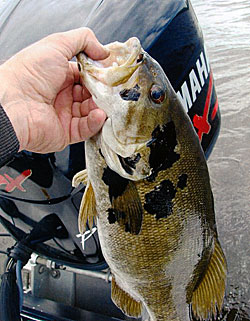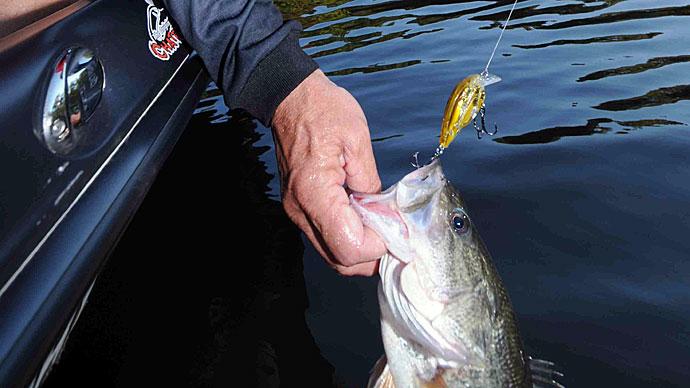
Have you noticed an increased number of black blotches on the sides and fins of the bass in your lake or pond? If so, you may be worrying about the cause of the blotching and the health of your fish.
1985 biologists and anglers started reporting unusual dark blotches on bass in the Hudson. The markings were the result of an increased number of dark pigment cells in the skin and fins. There was no noticeable change in the frequency of these sightings between 1985 and 1988, but by 1986 biologists in other states started reporting similarly marked bass. Most of these initial sightings were in eastern coastal areas and a few heavily fished impoundments in the central and southern states.
Between 1985 and 1989 several scientific studies* attempted to identify the causes of blotching. The markings were found mainly in bass 12 inches or longer. Parasites and diseases were ruled out as the cause of the blotching, and the bass did not show any other specific cellular pathology.
One study ruled out a viral cause. When inoculated with sera from affected bass, non-blotched bass failed to develop blotches or associated skin lesions, and other fish species were not affected. Previous studies of unusual markings on other fish species related abnormal blotches to environmental contaminants, viruses, heredity, the inflammatory responses of the skin's immune system, or changes in hormones that regulated skin pigment responses. In 1994 a research team** checked to see whether PCB, a common Hudson River pollutant found in high concentrations in Hudson River bass, was causing blotching. They found that while blotched Hudson River bass contained more PCB's than non-blotched bass from the same areas, they noted the blotches also occurred in samples from areas without high PCB concentrations. They concluded PCB's "may not be the cause of LMB black blotch syndrome."
Increased pigmentation in animal tissue is a natural defense mechanism against excessive exposure to solar radiation as well as many pollutants. Other factors might cause this blotching, too, so more study is needed to explain what is going on.

Before these reports were published, I'd seen a few bass with the dark blotching. Since then, the number of blotched fish has increased steadily, and sightings are now common on most Texas reservoirs and ponds I have fished. I suspect there is a tie-in with the increase in Catch-and-Release (C&R) bass fishing since 1990. The increased percentage of blotched bass found in bass of larger sizes could easily be associated with C&R, particularly with forced releases in waters with slot limits.
I moved near a lightly fished pond 17 years ago. At first, the fish I caught had no blotches. Since then, I've caught and released about 500 bass per year in this pond; most have been caught and released repeatedly. I've identified some re-caught individuals by their specific marks, and have noticed about a third of those bass now show blotching, often around the mouth. I've also caught fish with distinct and identifiable blotches at Lake Fork and Ray Hubbard reservoirs where C&R of bass is now common.
Although contaminants may be associated with the blotches, I suspect that handling during the hooking and capture process and subsequent release are major causal factors. Marks near mouths are easily attributed to lip- landing techniques. Those on other parts of the body seem to be located at places where bass may have touched a boat, the ground, or cover while hooked. The lower tail and anal fins seem to be particularly vulnerable.
The blotches disappear after 3-9 months, suggesting they may be part of a skin or slime repairing process. The pond fish I catch in late January have few blotches, but the number of blotches increases over the remainder of the year when C&R fishing pressure has increased. I've also noted that blotches seem to disappear faster in smaller adult bass. The largest bass seem to hold some marks for a year or more.

Although diseases are not considered part of the cause, a genetic propensity to show blotching might be. Blotching might be an inherited genetic response to any source of skin damage or irritation, explaining why some bass don't seem to blotch. If this is the case, C&R could play a part simply by increasing the sighting and handling of blotchable fish.
Long time fisheries biologist and editor of Pond Boss magazine, Bob Lusk said, "I first encountered bass with large black spots in a lake in western Arkansas back in the late 1980's. In that lake, there were three different sized bass, all adult, that showed that deep black coloring in large spots. I thought it was something hereditary." He continued, "Since then, I'll see that phenomenon from time to time in private waters. Where I do see it, it's prevalent in that population. I have no idea what causes it, other than those individual fish produce melanin. My thought all along is that it's hereditary, but I don't truly know."
Although largemouth bass first displayed blotching, in the last decade smallmouth bass have also shown increased blotching, particularly in areas where bass angling and C&R has increased.
Whatever the cause of black bass blotching, it is becoming more common in reservoirs and ponds. There seems to be no reason to worry about the health or edibility of blotchy bass, but if your pond bass are showing increased black markings, it may reveal a need to more carefully land, handle, and release healthy fish.
* Carlson, D. M. 1989. Unusual pigmentation on largemouth bass. Presentation to the 45th Annual NE Fish and Wildl. Conf., Ellenville, NY, (Mimeo) 8p.
**Skinner, K. M., L. Pagels, andK. A. Peregrim. 1994. Black blotch largemouth bass in the Hudson River, New York. Presentation given at the New York natural History Conference III, April 13-16,1994. (Mimeo) 29p.
Reprinted with permission from Pond Boss Magazine



